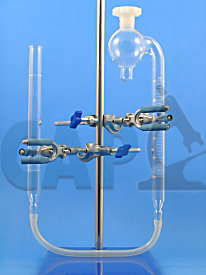Ganong’s Respirometer

Ganong’s respirometer is a specialised device used to accurately measure the respiration rate of plants or other organisms by determining the amount of oxygen consumed or carbon dioxide produced during respiration. The respirometer consists of a sealed container that contains a plant or organism, a pipette containing a potassium hydroxide (KOH) solution to absorb carbon dioxide, and a small vial containing a measured amount of air.
Table of Contents
Set up of Ganong’s Respirometer
To use Ganong’s respirometer, the organism is carefully placed inside the container, and the pipette and vial are inserted into the container. The container is sealed, and the respirometer is left for a period of time. During this time, the organism will consume oxygen and produce carbon dioxide, which will be absorbed by the KOH solution in the pipette. As a result, the volume of air in the vial will decrease.
The respiration rate of the organism can be calculated by measuring the volume of air that was consumed, which is equal to the difference in volume between the initial volume of air in the vial and the final volume of air in the vial. The respiration rate can be expressed as the volume of oxygen consumed per unit of time or the volume of carbon dioxide produced per unit of time, depending on the specific experiment.
Ganong’s respirometer is a useful tool for studying the respiration of plants and other organisms and can provide insights into how respiration is affected by different environmental conditions, such as temperature, light, and humidity.
Application: Calculation of RQ
Respiratory quotient (RQ) is a measure of the ratio of the amount of carbon dioxide (CO2) produced to the amount of oxygen (O2) consumed during respiration. It is typically calculated as the ratio of the volume of CO2 produced to the volume of O2 consumed, or as the ratio of the moles of CO2 produced to the moles of O2 consumed.
The respiratory quotient can provide information about the type of respiratory substrate that an organism is using. Different substrates, such as carbohydrates, fats, and proteins, have different RQ values because they require different amounts of O2 and produce different amounts of CO2 during respiration. For example, carbohydrates have an RQ of 1.0 because they are completely oxidized to CO2 and H2O, while fats have an RQ of 0.7 because they produce less CO2 per unit of O2 consumed.
The respiratory quotient can also provide information about the energy efficiency of an organism’s respiration. An RQ value less than 1.0 indicates that the organism is using a mixture of substrates, with fats being used more heavily, which results in more energy being produced per unit of O2 consumed. An RQ value greater than 1.0 indicates that the organism is metabolizing more carbohydrates than fats, which results in less energy being produced per unit of O2 consumed.
Also read, Respiratory quotient | RQ | Ganong’s respirometer | Class bsc bs botany – YouTube
Check out D-dimer test – My Biology Dictionary



